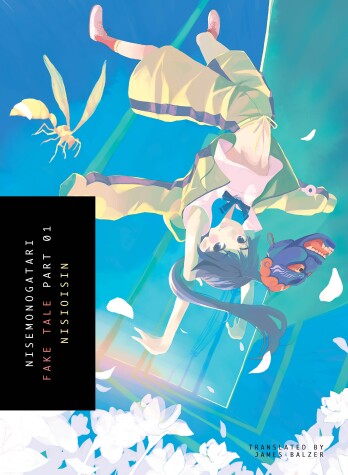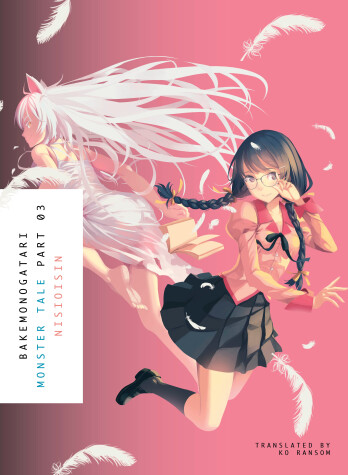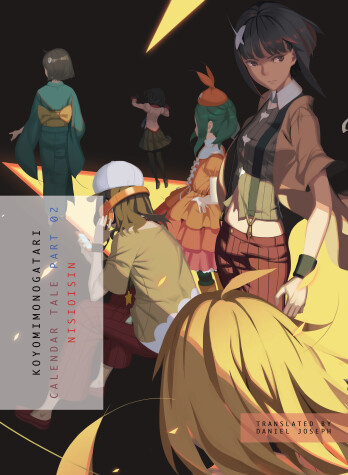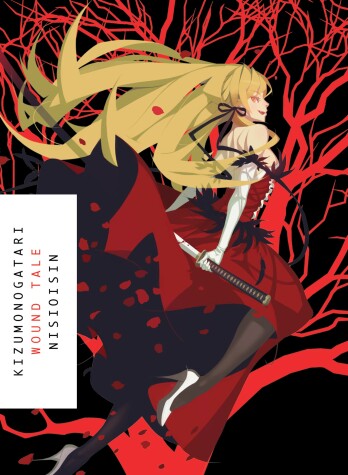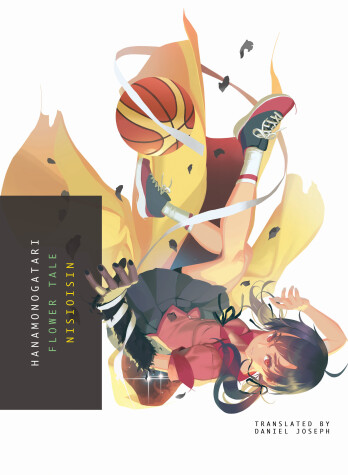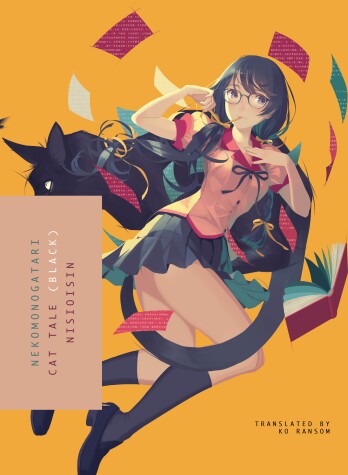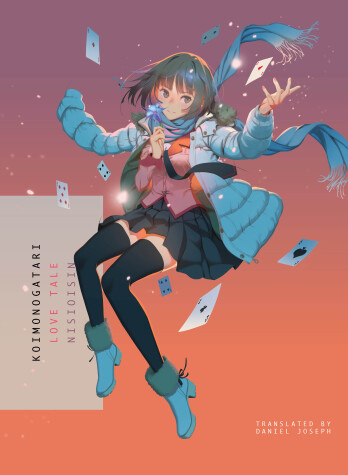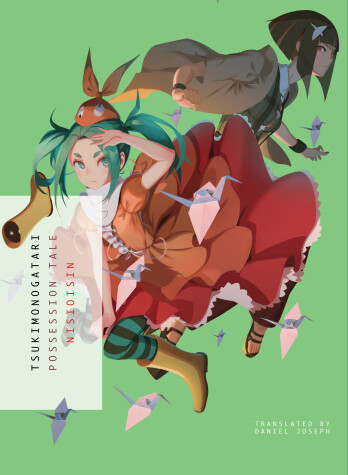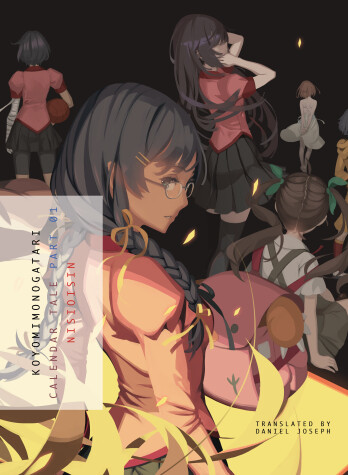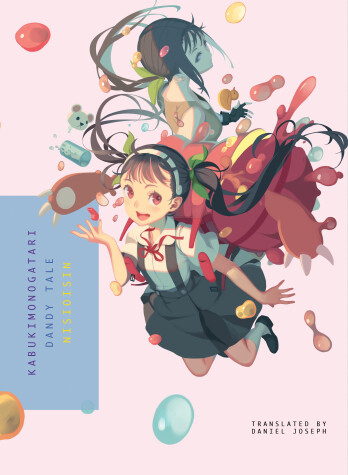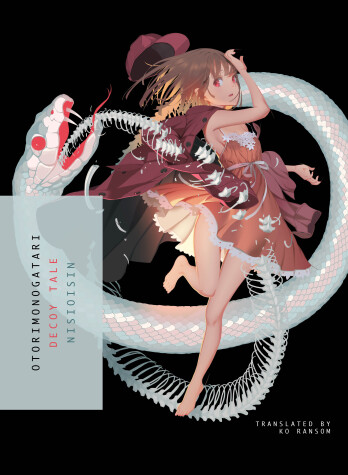Monogatari
5 primary works • 16 total works
Book 1
So begins a tale of mysterious maladies that are supernatural in origin yet deeply revealing of the human psyche, a set of case files as given to unexpected feeling as it is to irreverent humor. So begins the legendary novel that kicked off the MONOGATARI series, whose anime adaptations have enjoyed international popularity and critical acclaim.
This first of three parts introduces Senjogahara and Hachikuji, and fans of the blockbuster prequel KIZUMONOGATARI will be delighted to meet their favorite crazies again: the weirdly reliable narrator Araragi, class president among class presidents Hanekawa, shady problem-solver Oshino, and a certain pale, blonde former vampire.
Book 1
Karen is the brawn and Tsukihi the brains of a vigilantism that the pair sees not merely as defending justice but as justice itself. They can’t encounter a harmful fad without trying to hunt down a specific source that had a motive for spreading it. In their big brother’s humble opinion, there is something fake and precarious about it all.
In this first of two parts, the immediate sequel to the legendary BAKEMONOGATARI plunges us into the middle of summer vacation in the mostly peaceful rural town where the series is set. As our hero and narrator can say from experience, however, teenagers with too much free time on their hands can get stung pretty badly.
Book 2
In the first half of Fake Tale, lost soul Araragi helped resolve his bigger little sister Karen’s feverish run-in with a fraud. In this second half, he must attend to his littler little sister Tsukihi’s issues, but not before staging the Toothbrush Episode that the acclaimed anime adaptation’s viewers find quite memorable—whether they like to or not.
As fraught with ominousness as a dark empty street, as unexpectedly full of feeling as an acid-tongued girlfriend, as sidesplittingly funny as a horny retired jock, and (maybe even) as educational as college in the best MONOGATARI tradition, this volume also introduces us to “ghostbusters” Yozuru Kagenui and Yotsugi Ononoki.
Book 2
A self-described loser, Koyomi Araragi is struggling at a prep school that he should never have gotten into. He has all but quit caring, but as a senior, he faces the chilling scenario of not being able to graduate. It’s time to cram, but the supernatural aberrations that keep on popping up in his provincial town won’t let him be.
Previously, our hero turned into a vampire and back, gained an acid-tongued girlfriend, and couldn’t find his way home thanks to a lost child. In this second of three parts, which introduces Suruga Kanbaru and Nadeko Sengoku, he becomes embroiled in a case that riffs on a classic English story from 1902.
Book 3
Loser extraordinaire Koyomi Araragi owes her his post of class vice president and a more significant debt of gratitude for her unstinting support during the darkest spring break of his life. All of it has blinded him to the possibility that his saintly classmate’s family situation might be no less adverse than that of his other lady friends.
Thus, at last, we face Hanekawa’s unlikely aberration in “Tsubasa Cat”—the concluding part of the legendary novel that captured the sensibilities of a new generation in the aught years and spawned an animated series that has won international popularity and acclaim—before the story continues with a Fake Tale...
Continuing with the motif of ways, paths, roads, and streets, and wrapping up sundry other topics and quasi-philosophical concerns, the vignettes for the months of October to March deal with six ladies who are either not quite human or older than titular narrator Koyomi Araragi, bless his bantering soul.
In this installment, see how he handles—or is handled by—aberration of a little sister Tsukihi, enigma of a freshman or -woman Ogi, shadow of a legendary vampire Shinobu, corpse of a tween girl Ononoki, psychopath of a monster expert Kagenui, and know-it-all of a Machiavellian fixer Izuko Gaen.
Koyomi Araragi, who prefers to avoid having friends because they'd lower his “intensity as a human," is naturally skeptical. Yet it is to him that the bloodsucking demon, a concept “dated twice over," beckons on the first day of spring break as he makes his way home with a fresh loot of morally compromising periodicals.
Always disarmingly candid, often hilariously playful, and sometimes devastatingly moving, KIZUMONOGATARI: Wound Tale is the perfect gateway into the world of author NISIOISIN, the bestselling young novelist in Japan today. The prequel to BAKEMONOGATARI (“Monster Tale"), this is where the legendary MONOGATARI series, whose anime adaptations have enjoyed international popularity and critical acclaim, begins. A theatrical feature based on KIZUMONOGATARI is due to be released in Japan in January 2016.
Bereft of the company of her beloved mentors, the only other person around her with any working knowledge of aberrations the junior Ogi Oshino, apparently a relative of the Hawaiian-shirted folklorist, she feels a bit alone and blue, and sick with dread that the devil residing in her left arm courtesy of the Monkey’s Paw might act up again while she sleeps.
Investigating a rumor that she fears might lead back to her, the former star ends up peering into an abyss of negativity called Roka—a “wax flower” to take the characters’ meaning. Trapped in a pit the like of which could only be escaped by the one girl who was able to pull off slam-dunks in her basketball nationals, can the penitent Kanbaru, however, still be aggressive?
Like KIZUMONOGATARI, which delved into our narrator’s disastrous spring break, Cat Tale (Black) is a prequel about another catastrophe, mentioned often yet never recounted even in a foregoing chapter dedicated to Miss H.: namely, the model student’s rampage over Golden Week, a string of holidays starting at the end of April.
Closing out what has come to be known as the “First Season” of the series, this episode of ’GATARI, as rich as ever in silly banter and poignant profundities, richer than usual in snide meta comments about the anime, will make you laugh and cry, or just put a grownup smile on your face, maybe, but is guaranteed to stay with you forever.
Because the teller of the tale, who has been summoned by the heroine to defuse the situation, despite having been her nemesis since the very outset of the series, is—in the absence of the equally shady adult, Oshino, who at least was an expert—none other than his college frenemy, the fake ghostbuster who doesn’t believe in ghosts, the shameless swindler Deishu Kaiki.
And it is indeed a con that he agrees to perpetrate, uncharacteristically pro bono, on a wrathful god—a mythic undertaking if true, which it may be, when a liar among liars holds that his story, like any other, is all a lie. But maybe not, when a man who claims to be wise in the ways of the world sounds just as self-conscious as his adolescent counterparts or a Russian anti-hero.
Before ever visiting Japan to find a place to die, four centuries, indeed, before her failed suicide attempt, the legendary vampire Kissshot literally stepped foot on the land of the rising sun with an epic jump that ended a lonely sojourn in Antarctica. It was back in those days that the proud noble created her first thrall. It was then, too, that she first met the Darkness.
Having messed with a more recent past with her help, and returning to the present to reunite with two more characters that look like little girls but are actually his elders, Thrall No. 2 Araragi reclaims the mic only to cede it in large part to the bloodsucking demon who goes by “Shinobu” these days. Her story, though, may not even be the most poignant one told herein.
At issue now is not the precarious fate of one of his cherished confrères, or rather consœurs, whom he’d aid, sight unseen, with a monster’s resilience, but his own aberrant state and its prolonged abuse. If everything comes with a bill, and if no man is an island, then is the price of self-sacrificing amity—and the bloodshed it ironically occasions—becoming inhuman for good?
That being said! Our hero, whose first name means “calendar” but who has none in his room, sees no need to rush, so, on our way to the profound mysteries of the superhuman aspect, expect a super-shallow deconstruction of the alarm clock. On hand this volume to (hardly ever) humor his humor: his little sisters, a living doll of a corpse, and its violent mistress.
Weaving in a motif of ways, paths, roads, and streets—walks of life—the nostalgic vignettes hark back to the “case files” feel of the series-launching Monster Tale, but with a twist. Not all oddities are supernatural: stones and flowers; sand and water; the wind and the tree can just be plain weird without being aberrations.
In this installment, say hello from the future to class president among class presidents Hanekawa, acid-tongued girlfriend Senjogahara, cheeky lost child Hachikuji, smutty athlete Kanbaru, pathologically shy Sengoku, and justice-loving martial artist Karen, young ladies who love to make our young man sweat.
Thus the tale is also, or more so, about the journey itself, the dark honeymoon of a trip he takes into the past with the dweller in his shadow, Shinobu. Even among a cast that routinely disrespects chronology with their meta-commentary, she takes the cake, or the donut, by rewinding the clock for a perverse road movie, one that by and large goes nowhere, spatially.
It’s Kabuki not as in the theater, but with the character for “tilt”—as in a slanted attitude toward the world, the posture of a bohemian. Or, perhaps, of a legendary vampire who once sought death, and of a high school senior who once tuned out life doing their dandy best to attend to an embarrassing wealth of aberrations in a provincial town.
When a jealous classmate tried to hex her with a fraudulent charm, Miss Bangs went and got cursed in earnest all by herself, having done her homework wrong and performed a gruesome ritual at a forgotten shrine. Thank goodness Big Brother Koyomi noticed and rescued her that time, but chopping up snakes at a place of worship that was dedicated to a serpent…
It might come back to bite her again, hmmmm? Hoping to be saved by someone, but unable to ask for help, the shyest member of the cast explores a running theme of these tales in her own halting voice this round: While self-reliance is well and good, beware of its debased counterfeit minted from a mere reluctance to connect with others. You know what I mean?
The bone-chilling brokenness of her household, where father and mother and daughter keep three separate sets of cookware in the same kitchen and only ever prepare their own meals, and the profound darkness nurtured in the genius schoolgirl’s heart, come to life, if that is the word, through her self-vivisection.
As for our customary unreliable narrator, Araragi, we seem to learn revealing tidbits about him now that we have an outside view of him at last, while his lady friends Senjogahara, Hachikuji, et al, freed from his predilection for proudly inane banter, show subtly new faces to us via their female interlocutor. Welcome to the Second Season.

